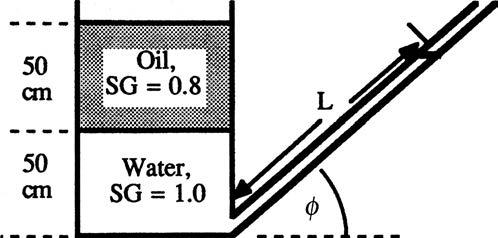
13 minute read
Chapter 2 • Pressure Distribution in a Fluid
P2.1 For the two-dimensional stress field in Fig. P2.1, let Find the shear and normal stresses on plane AA cutting through at 30°
Solution: Make cut “AA” so that it just hits the bottom right corner of the element. This gives the freebody shown at right. Now sum forces normal and tangential to side AA. Denote side length AA as “L.”
Advertisement
P2.2 For the stress field of Fig. P2.1, change the known data to σxx = 2000 psf, σyy = 3000 psf, and σn(AA) = 2500 psf. Compute σxy and the shear stress on plane AA.
Solution: Sum forces normal to and tangential to AA in the element freebody above, with σn(AA) known and σxy unknown:
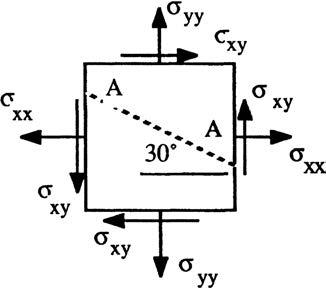
In like manner, solve for the shear stress on plane AA, using our result for σxy:
This problem and Prob. P2.1 can also be solved using Mohr’s circle.
P2.3 A vertical clean glass piezometer tube has an inside diameter of 1 mm. When a pressure is applied, water at 20°C rises into the tube to a height of 25 cm. After correcting for surface tension, estimate the applied pressure in Pa.
Solution: For water, let Y = 0.073 N/m, contact angle θ = 0°, and γ = 9790 N/m3. The capillary rise in the tube, from Example 1.9 of the text, is
Then the rise due to applied pressure is less by that amount: hpress = 0.25 m 0.03 m = 0.22 m. The applied pressure is estimated to be p = γhpress = (9790 N/m3)(0.22 m) ≈ 2160 Pa Ans.
P2.4 Pressure gages, such as the Bourdon gage in Fig. P2.4, are calibrated with a deadweight piston.
If the Bourdon gage is designed to rotate the pointer
10 degrees for every 2 psig of internal pressure, how many degrees does the pointer rotate if the piston and weight together total 44 newtons?
Solution: The deadweight, divided by the piston area, should equal the pressure applied to the Bourdon gage. Stay in SI units for the moment:
At 10 degrees for every 2 psig, the pointer should move approximately 100 degrees. Ans.
P2.5 Quito, Ecuador has an average altitude of 9,350 ft. On a standard day, pressure gage A in a laboratory experiment reads 63 kPa and gage B reads 105 kPa. Express these readings in gage pressure or vacuum pressure, whichever is appropriate.
Solution: Convert 9,350 ft x 0.3048 = 2,850 m. We can interpolate in the Standard Altitude Table A.6 to a pressure of about 71.5 kPa. Or we could use Eq. (2.20):
Good interpolating! Then pA = 71500-63000 = 8500 Pa (vacuum pressure) Ans.(A), and pB = 105000 - 71500 = 33500 Pa (gage pressure) Ans.(B)
P2.6 Express standard atmospheric pressure as a head, h = p/ρg, in (a) feet of glycerin; (b) inches of mercury; (c) meters of water; and (d) mm of ethanol.
Solution: Take the specific weights, γ = ρg, from Table A.3, divide patm by γ :
(a) Glycerin: h = (2116 lbf/ft2)/(78.7 lbf/ft3) ≈ 26.9 ft Ans. (a)
(b) Mercury: h = (2116 lbf/ft2)/(846 lbf/ft3) = 2.50 ft ≈ 30.0 inches Ans. (b)
(c) Water: h = (101350 N/m2)/(9790 N/m3) ≈ 10.35 m Ans. (c)
(d) Ethanol: h = (101350 N/m2)/(7740 N/m3) = 13.1 m ≈ 13100 mm Ans. (d)
P2.7 La Paz, Bolivia is at an altitude of approximately 12,000 ft. Assume a standard atmosphere. How high would the liquid rise in a methanol barometer, assumed at 20°C? [HINT: Don’t forget the vapor pressure.]
Solution: Convert 12,000 ft to 3658 meters, and Table A.6, or Eq. (2.20), give
From Table A.3, methanol has ρ = 791 kg/m3 and a large vapor pressure of 13,400 Pa. Then the manometer rise h is given by
P2.8 Suppose, which is possible, that there is a half-mile deep lake of pure ethanol on the surface of Mars. Estimate the absolute pressure, in Pa, at the bottom of this speculative lake.
Solution: We need some data from the Internet: Mars gravity is 3.71 m/s2, surface pressure is 700 Pa, and surface temperature is -10ºF (above the freezing temperature of ethanol). Then the bottom pressure is given by the hydrostatic formula, with ethanol density equal to 789 kg/m3 from Table A.3. Convert ½ mile = ½(5280) ft = 2640 ft * 0.3048 m/ft = 804.7 m. Then
P2.9 A storage tank, 26 ft in diameter and 36 ft high, is filled with SAE 30W oil at 20°C. (a) What is the gage pressure, in lbf/in2, at the bottom of the tank? (b) How does your result in (a) change if the tank diameter is reduced to 15 ft? (c) Repeat (a) if leakage has caused a layer of 5 ft of water to rest at the bottom of the (full) tank.
Solution: This is a straightforward problem in hydrostatic pressure. From Table A.3, the density of SAE 30W oil is 891 kg/m3 ÷ 515.38 = 1.73 slug/ft3. (a) Thus the bottom pressure is pbottom = ρoil gh = (1.73 slug ft 3 )(32.2 ft s 2 )(36 ft ) = 2005 lbf ft 2 = 13.9 lbf in 2 gageAns.( a )
(b) The tank diameter has nothing to do with it, just the depth: pbottom = 13.9 psig. Ans.(b)
(c) If we have 31 ft of oil and 5 ft of water (ρ = 1.94 slug/ft3), the bottom pressure is
P2.10 A large open tank is open to sea level atmosphere and filled with liquid, at 20ºC, to a depth of 50 ft. The absolute pressure at the bottom of the tank is approximately 221.5 kPa. From Table A.3, what might this liquid be?
Solution: Convert 50 ft to 15.24 m. Use the hydrostatic formula to calculate the bottom pressure:
P2.11 In Fig. P2.11, sensor A reads 1.5 kPa (gage). All fluids are at 20°C. Determine the elevations Z in meters of the liquid levels in the open piezometer tubes B and C.
Solution: (B) Let piezometer tube B be an arbitrary distance H above the gasolineglycerin interface. The specific weights are γair ≈ 12.0 N/m3, γgasoline = 6670 N/m3, and γglycerin = 12360 N/m3. Then apply the hydrostatic formula from point A to point B:
Solve for ZB = 2.73 m (23 cm above the gasoline-air interface) Ans. (b)
Solution (C): Let piezometer tube C be an arbitrary distance Y above the bottom. Then
1500 + 12.0(2.0) + 6670(1.5) + 12360(1.0 Y) 12360(ZC Y) = pC = 0 (gage)
Solve for ZC = 1.93 m (93 cm above the gasoline-glycerin interface) Ans. (c)

P2.12 In Fig. P2.12 the tank contains water and immiscible oil at 20°C. What is h in centimeters if the density of the oil is 898 kg/m3?
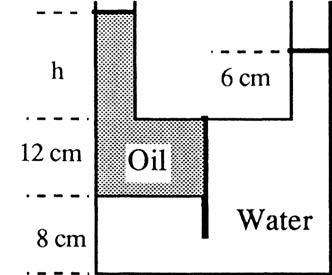
Solution: For water take the density = 998 kg/m3. Apply the hydrostatic relation from the oil surface to the water surface, skipping the 8-cm part:
P2.13 In Fig. P2.13 the 20°C water and gasoline are open to the atmosphere and are at the same elevation. What is the height h in the third liquid?
Solution: Take water = 9790 N/m3 and gasoline = 6670 N/m3. The bottom pressure must be the same whether we move down through the water or through the gasoline into the third fluid:
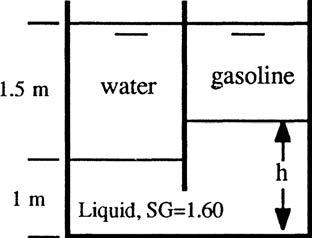
P2.14 For the three-liquid system shown, compute h1 and h2 Neglect the air density.
Solution: The pressures at the three top surfaces must all be atmospheric, or zero gage pressure. Compute γoil = (0.78)(9790) = 7636 N/m3. Also, from Table 2.1, γwater = 9790 N/m3 and γmercury = 133100 N/m3 . The surface pressure equality is
P2.15 In Fig. P2.15 all fluids are at 20°C. Gage A reads 15 lbf/in2 absolute and gage B reads 1.25 lbf/in2 less than gage C. Com-pute (a) the specific weight of the oil; and (b) the actual reading of gage C in lbf/in2 absolute.
Solution: First evaluate γair = (pA/RT)g = [15 × 144/(1717 × 528)](32.2) ≈ 0.0767 lbf/ft3. Take γwater = 62.4 lbf/ft3. Then apply the hydrostatic formula from point B to point C:
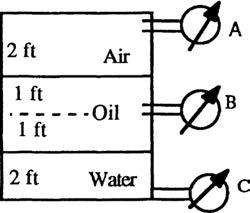
With the oil weight known, we can now apply hydrostatics from point A to point C:
P2.16 If the absolute pressure at the interface between water and mercury in Fig. P2.16 is 93 kPa, what, in lbf/ft2, is (a) the pressure at the surface, and (b) the pressure at the bottom of the container?
Solution: Do the whole problem in SI units and then convert to BG at the end. The bottom width and the slanted 75-degree walls are irrelevant red herrings. Just go up and down:
P2.17 The system in Fig. P2.17 is at 20ºC.
Determine the height h of the water in the left side.
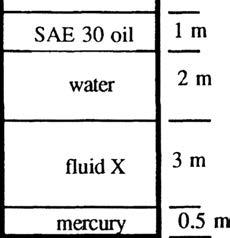
Solution: The bottom pressure must be the same from both left and right viewpoints:
P2.18 All fluids in Fig. P2.18 are at 20°C. If atmospheric pressure = 101.33 kPa and the bottom pressure is 242 kPa absolute, what is the specific gravity of fluid X?
Solution: Simply apply the hydrostatic formula from top to bottom:
P2.19 The U-tube at right has a 1-cm ID and contains mercury as shown. If 20 cm3 of water is poured into the right-hand leg, what will be the free surface height in each leg after the sloshing has died down?
Solution: First figure the height of water added:
Then, at equilibrium, the new system must have 25.46 cm of water on the right, and a 30-cm length of mercury is somewhat displaced so that “L” is on the right, 0.1 m on the bottom, and “0.2 L” on the left side, as shown at right. The bottom pressure is constant:
Thus right-leg-height = 9.06 + 25.46 = 34.52 cm Ans. left-leg-height = 20.0 9.06 = 10.94 cm Ans.
P2.20 The hydraulic jack in Fig. P2.20 is filled with oil at 56 lbf/ft 3 . Neglecting piston weights, what force F on the handle is required to support the 2000- lbf weight shown?
Solution: First sum moments clockwise about the hinge A of the handle: or: F = P/16, where P is the force in the small (1 in) piston. Meanwhile figure the pressure in the oil from the weight on the large piston:
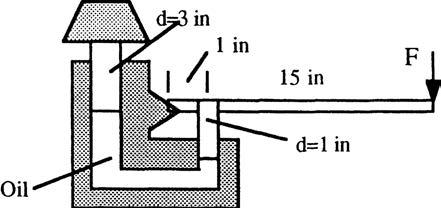
Therefore the handle force required is F = P/16 = 222/16 ≈ 14 lbf Ans.
P2.21 In Fig. P2.21 all fluids are at 20°C. Gage A reads 350 kPa absolute. Determine (a) the height h in cm; and (b) the reading of gage B in kPa absolute.
Solution: Apply the hydrostatic formula from the air to gage A:
Then, with h known, we can evaluate the pressure at gage B:
P2.22 The fuel gage for an auto gas tank reads proportional to the bottom gage pressure as in Fig. P2.22. If the tank accidentally contains 2 cm of water plus gasoline, how many centimeters “h” of air remain when the gage reads “full” in error?
Solution: Given γgasoline = 0.68(9790) = 6657 N/m3, compute the gage pressure when “full”: Set this pressure equal to 2 cm of water plus “Y” centimeters of gasoline:
Therefore the air gap h = 30 cm 2 cm(water) 27.06
≈ 0.94 cm Ans.
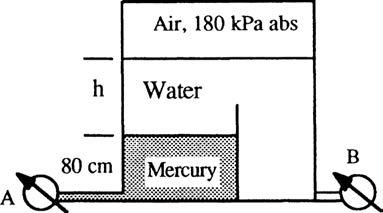
P2.23 In Fig. P2.23 both fluids are at 20°C. If surface tension effects are negligible, what is the density of the oil, in kg/m3?
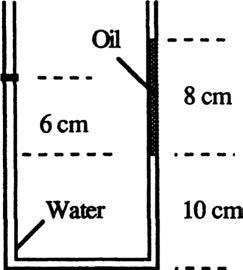
Solution: Move around the U-tube from left atmosphere to right atmosphere:
P2.24 In Prob. 1.2 we made a crude integration of atmospheric density from Table A.6 and found that the atmospheric mass is approximately m ≈ 6E18 kg. Can this result be used to estimate sea-level pressure? Can sea-level pressure be used to estimate m?
Solution: Yes, atmospheric pressure is essentially a result of the weight of the air above. Therefore the air weight divided by the surface area of the earth equals sea-level pressure:
This is a little off, thus our mass estimate must have been a little off. If global average sea-level pressure is actually 101350 Pa, then the mass of atmospheric air must be more nearly
*P2.25 As measured by NASA’s Viking landers, the atmosphere of Mars, where g = 3.71 m/s2, is almost entirely carbon dioxide, and the surface pressure averages 700 Pa. The temperature is cold and drops off exponentially: T ≈ To e-Cz, where C ≈ 1.3E-5 m-1 and To ≈ 250 K. For example, at 20,000 m altitude, T ≈ 193 K. (a) Find an analytic formula for the variation of pressure with altitude. (b) Find the altitude where pressure on Mars has dropped to 1 pascal.
Solution: (a) The analytic formula is found by integrating Eq. (2.17) of the text:
(b) From Table A.4 for CO2, R = 189 m2/(s2-K). Substitute p = 1 Pa to find the altitude:
P2.26 For gases over large changes in height, the linear approximation, Eq. (2.14), is inaccurate. Expand the troposphere power-law, Eq. (2.20), into a power series and show that the linear approximation p ≈ pa - ρa g z is adequate when
Solution: The power-law term in Eq. (2.20) can be expanded into a series: Multiply by pa, as in Eq. (2.20), and note that panB/To = (pa/RTo)gz = ρa gz. Then the series may be rewritten as follows:
For the linear law to be accurate, the 2nd term in parentheses must be much less than unity. If the starting point is not at z = 0, then replace z by δz:
P2.27 This is an experimental problem: Put a card or thick sheet over a glass of water, hold it tight, and turn it over without leaking (a glossy postcard works best). Let go of the card. Will the card stay attached when the glass is upside down? Yes: This is essentially a water barometer and, in principle, could hold a column of water up to 10 ft high!
P2.28 A correlation of computational fluid dynamics results indicates that, all other things being equal, the distance traveled by a well-hit baseball varies inversely as the 0.36 power of the air density. If a home-run ball hit in NY Mets Citi Field Stadium travels 400 ft, estimate the distance it would travel in (a) Quito, Ecuador, and (b) Colorado Springs, CO.
Solution: Citi Field is in the Borough of Queens, NY, essentially at sea level. Hence the standard pressure is po ≈ 101,350 Pa. Look up the altitude of the other two cities and calculate the pressure:
Then the estimated home-run distances are:
The Colorado result is often confirmed by people who attend Rockies baseball games.
P2.29 Follow up on Prob. P2.8 by estimating the altitude on Mars where the pressure has dropped to 20% of its surface value. Assume an isothermal atmosphere, not the exponential variation of P2.25.
Solution: Problem P2.8 we used a surface temperature To = -10ºF = -23ºC = 250 K. Recall that gMars ≈ 3.71 m/s2. Mars atmosphere is primarily CO2, hence RMars ≈ 189 m2/s2·K from Table A.4. Equation (2.18), for an isothermal atmosphere, thus predicts
P2.30 For the traditional equal-level manometer measurement in Fig. E2.3, water at 20°C flows through the plug device from a to b. The manometer fluid is mercury. If L = 12 cm and h = 24 cm, (a) what is the pressure drop through the device? (b) If the water flows through the pipe at a velocity V = 18 ft/s, what is the dimensionless loss coefficient of the device, defined by K = Δp/(ρ V2)? We will study loss coefficients in Chap. 6.
Solution: Gather density data: ρmercury = 13550 kg/m3, ρwater = 998 kg/m3. Example 2.3, by going down from (a) to the mercury level, jumping across, and going up to (b), found the very important formula for this type of equal-leg manometer:
(b) The loss coefficient calculation is straightforward, but we check the units to make sure. Convert the velocity from 18 ft/s to 5.49 m/s. Then
P2.31 In Fig. P2.31 determine Δp between points A and B. All fluids are at 20°C.
Solution: Take the specific weights to be
Benzene: 8640 N/m3 Mercury: 133100 N/m3
Water: 9790 N/m3 and γair will be small, probably around 12 N/m3. Work your way around from A to B:
Kerosene: 7885 N/m3
P2.32 For the manometer of Fig. P2.32, all fluids are at 20°C. If pB pA = 97 kPa, determine the height H in centimeters.
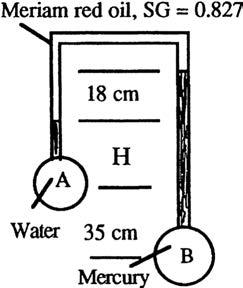
Solution: Gamma = 9790 N/m3 for water and 133100 N/m3 for mercury and (0.827)(9790) = 8096 N/m3 for Meriam red oil. Work your way around from point A to point B:
P2.33 In Fig. P2.33 the pressure at point A is 25 psi. All fluids are at 20°C. What is the air pressure in the closed chamber B?
Solution: Take γ = 9790 N/m3 for water, 8720 N/m3 for SAE 30 oil, and (1.45)(9790) = 14196 N/m3 for the third fluid. Convert the pressure at A from 25 lbf/in2 to 172400 Pa. Compute hydrostatically from point A to point B:
P2.34 To show the effect of manometer dimensions, consider Fig. P2.34. The containers (a) and (b) are cylindrical and are such that pa = pb as shown. Suppose the oil-water interface on the right moves up a distance Δh < h. Derive a formula for the difference pa pb when (a) and (b) d = 0.15D. What is the % difference?
Solution: Take γ = 9790 N/m3 for water and 8720 N/m3 for SAE 30 oil. Let “H” be the height of the oil in reservoir (b). For the condition shown, pa = pb, therefore
Case (a), When the meniscus rises Δh, there will be no significant change in reservoir levels. Therefore we can write a simple hydrostatic relation from (a) to (b): where we have used Eq. (1) above to eliminate H and L. Putting in numbers to compare later with part (b), we have Δp = Δh(9790 8720) = 1070 Δh, with Δh in meters.
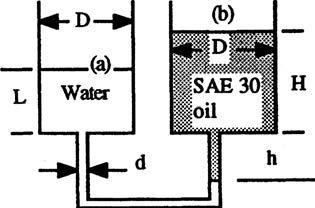
Case (b), d = 0.15D. Here we must account for reservoir volume changes. For a rise Δ h < h, a volume ( π/4)d 2 Δ h of water leaves reservoir (a), decreasing “L” by Δ h(d/D) 2 , and an identical volume of oil enters reservoir (b), increasing “H” by the same amount Δ h(d/D) 2 . The hydrostatic relation between (a) and (b) becomes, for this case, where again we have used Eq. (1) to eliminate H and L. If d is not small, this is a considerable difference, with surprisingly large error. For the case d = 0.15 D, with water and oil, we obtain Δp = Δh[1.0225(9790) − 0.9775(8720)] ≈ 1486 Δh or 39% more than (a).
P2.35 Water flows upward in a pipe slanted at 30°, as in Fig. P2.35. The mercury manometer reads h = 12 cm. What is the pressure difference between points (1) and (2) in the pipe?
Solution: The vertical distance between points 1 and 2 equals (2.0 m)tan 30° or 1.155 m. Go around the U-tube hydrostatically from point 1 to point 2:
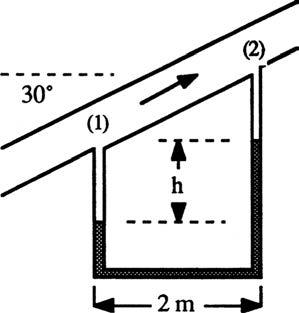
P2.36 In Fig. P2.36 both the tank and the slanted tube are open to the atmosphere. If L = 2.13 m, what is the angle of tilt φ of the tube?
Solution: Proceed hydrostatically from the oil surface to the slanted tube surface:
P2.37 The inclined manometer in Fig. P2.37 contains Meriam red oil, SG = 0.827. Assume the reservoir is very large. If the inclined arm has graduations 1 inch apart, what should θ be if each graduation represents 1 psf of the pressure pA?
Solution: The specific weight of the oil is (0.827)(62.4) = 51.6 lbf/ft3. If the reservoir level does not change and ΔL = 1 inch is the scale marking, then
